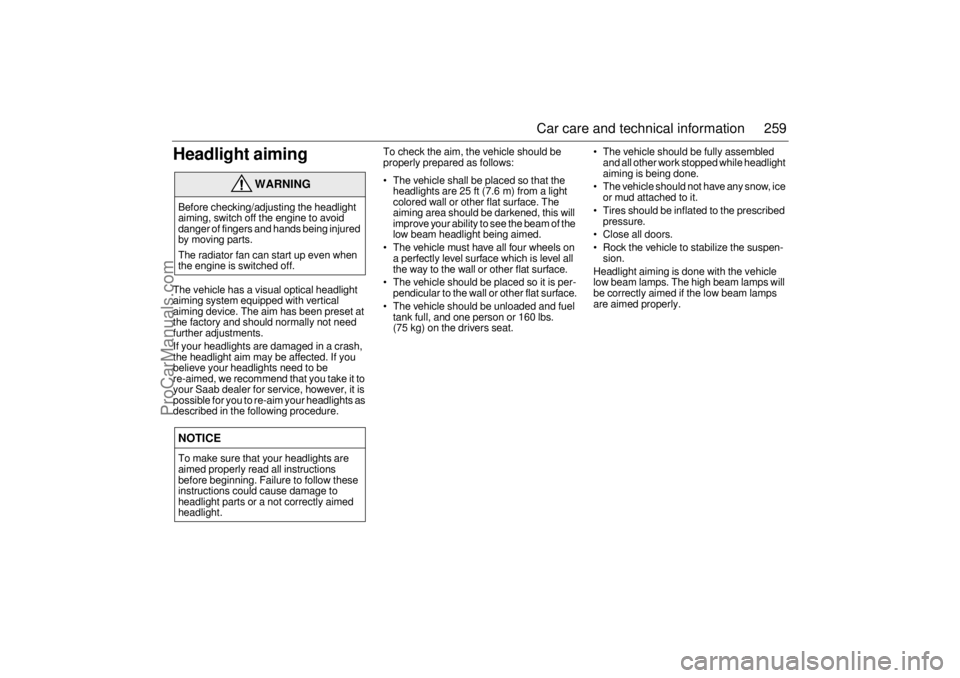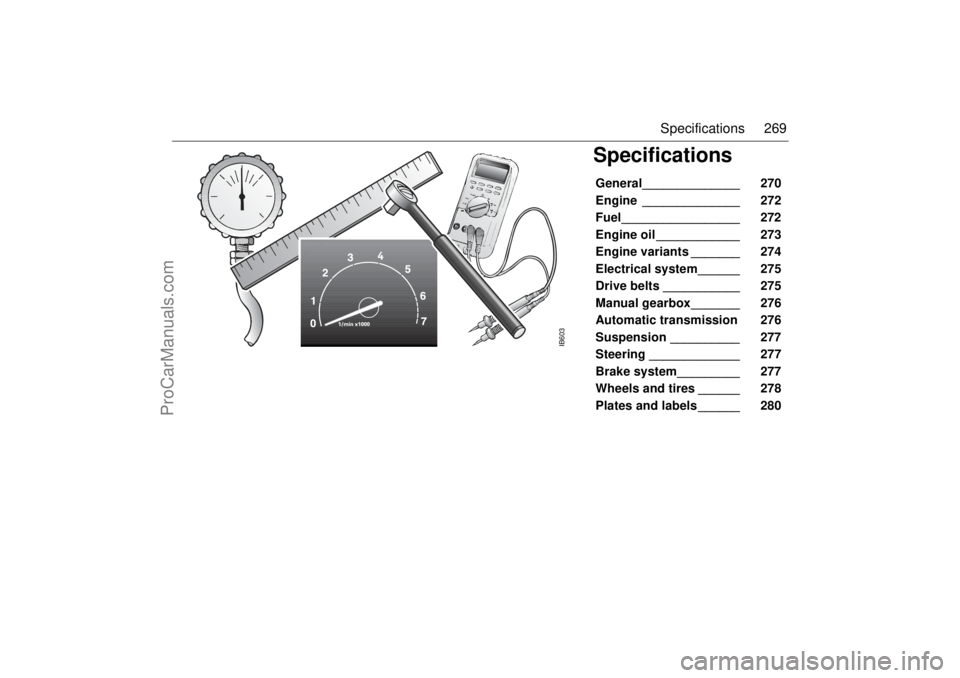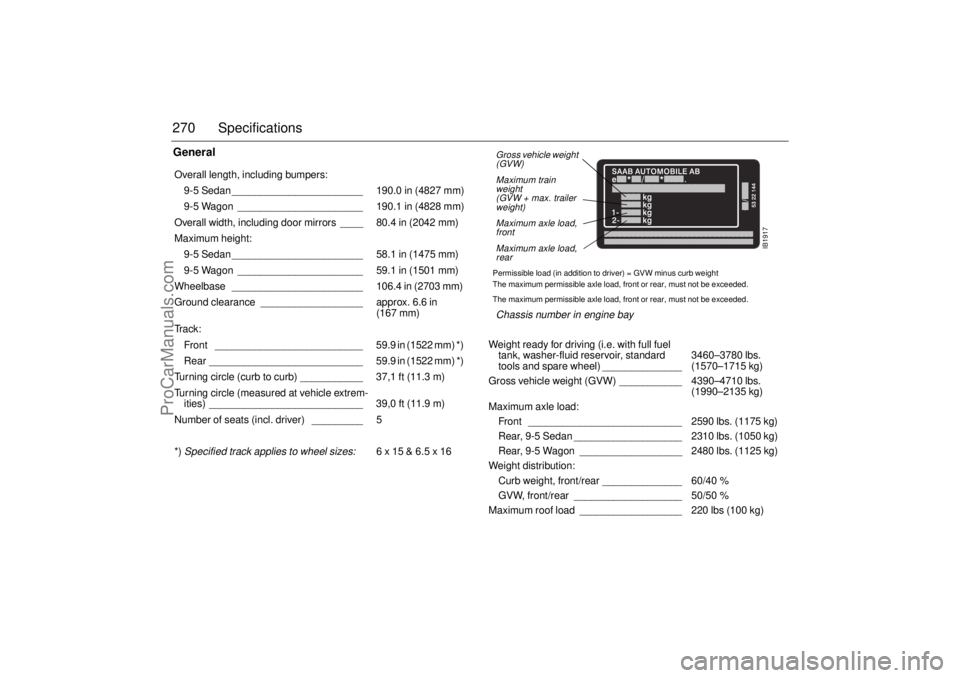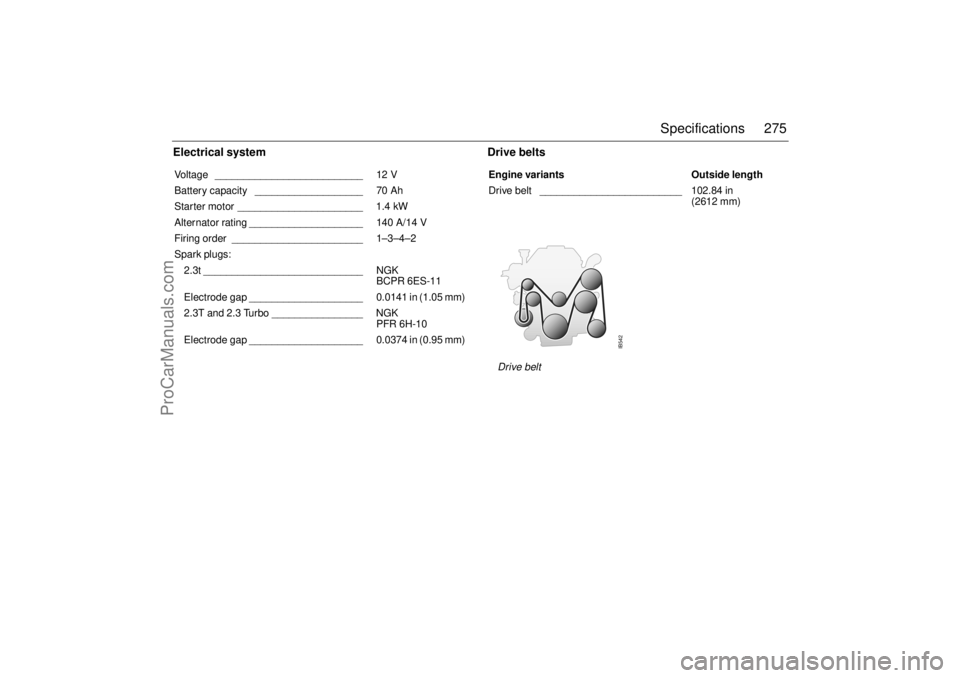engine SAAB 9-5 2004 Owners Manual
[x] Cancel search | Manufacturer: SAAB, Model Year: 2004, Model line: 9-5, Model: SAAB 9-5 2004Pages: 288, PDF Size: 16.91 MB
Page 258 of 288

258 Car care and technical information4Inspect the undercoating and touch
up if necessary.
Pay particular atten-
tion to the fenders and wheel housings,
which are exposed to abrasion by flying
gravel, etc. If the composition has worn
or flaked off, the steel must be thor-
oughly cleaned and dried before a fresh
coat is applied. The cleaning is best
done with a scraper and a steel wire
brush, followed by washing with solvent.
Apply the new coating thinly, as other-
wise it may run off or fall off when dry.
For long tripsBefore setting off on a long journey, it is
advisable to have your car checked over by
your Saab dealer.
Obtain a few important items to take along
on your journey such as spare bulbs, wiper
blades, fuses, a Poly-V-belt and the like.
You can check some points yourself before-
hand:
Make sure that the engine is in good con-
dition.
Check that no oil or gasoline leaks out of
the engine or gearbox/transmission.
Check the coolant and power steering
fluid levels. Check also for leaks.
Inspect the Poly-V-belt and replace it if it
shows any signs of hard wear.
Check the battery charge.
Check the tires for tread pattern and air
pressure, including the compact spare
wheel.
Check the brakes.
Check all bulbs.
Check for the presence of the tool kit and
the jack in the car.
Recovery and/or
recycling of automotive
materialsA typical car consists of metals (65–75 %),
plastics (10–15 %), rubber (5 %) and small
quantities of glass, wood, paper and tex-
tiles. The recycling of metals has been com-
monplace for a long time now.
To facilitate sorting of other materials for
recycling, plastic parts, for instance, have
been marked to identify the precise nature
of the plastic.
The quantity of materials in the car that can
be recycled or recovered depends on the
scrapping facilities in different countries. EU
legislation that comes into force in 2006 will
require a minimum of 85 % of the total
weight of materials to be recycled. How-
ever, every major car salvage yard in each
market will receive details from Saab of how
the highest percentage of materials can be
reclaimed.
ProCarManuals.com
Page 259 of 288

259 Car care and technical information
Headlight aiming The vehicle has a visual optical headlight
aiming system equipped with vertical
aiming device. The aim has been preset at
the factory and should normally not need
further adjustments.
If your headlights are damaged in a crash,
the headlight aim may be affected. If you
believe your headlights need to be
re-aimed, we recommend that you take it to
your Saab dealer for service, however, it is
possible for you to re-aim your headlights as
described in the following procedure.To check the aim, the vehicle should be
properly prepared as follows:
The vehicle shall be placed so that the
headlights are 25 ft (7.6 m) from a light
colored wall or other flat surface. The
aiming area should be darkened, this will
improve your ability to see the beam of the
low beam headlight being aimed.
The vehicle must have all four wheels on
a perfectly level surface which is level all
the way to the wall or other flat surface.
The vehicle should be placed so it is per-
pendicular to the wall or other flat surface.
The vehicle should be unloaded and fuel
tank full, and one person or 160 lbs.
(75 kg) on the drivers seat. The vehicle should be fully assembled
and all other work stopped while headlight
aiming is being done.
The vehicle should not have any snow, ice
or mud attached to it.
Tires should be inflated to the prescribed
pressure.
Close all doors.
Rock the vehicle to stabilize the suspen-
sion.
Headlight aiming is done with the vehicle
low beam lamps. The high beam lamps will
be correctly aimed if the low beam lamps
are aimed properly.
WARNING
Before checking/adjusting the headlight
aiming, switch off the engine to avoid
danger of fingers and hands being injured
by moving parts.
The radiator fan can start up even when
the engine is switched off.NOTICETo make sure that your headlights are
aimed properly read all instructions
before beginning. Failure to follow these
instructions could cause damage to
headlight parts or a not correctly aimed
headlight.
ProCarManuals.com
Page 264 of 288

264 Customer Assistance and InformationMaintenance scheduleThe Maintenance Schedule prescribes a
service program to the purchaser/operator
of a Saab that is reasonable and necessary
to ensure the proper emission control sys-
tems function, safety and reliability of the
Saab automobile in normal use. Additional
maintenance is recommended for specific
components when the car is operated under
certain severe conditions. Proper mainte-
nance is always good advice!
Authorized Saab dealers are equipped and
trained to meet your Saab’s service needs.
They regularly receive up-to-date Saab ser-
vice manuals and parts and technical ser-
vice bulletins from Saab and are able,
through their franchise agreement, to attend
Saab service schools, obtain Saab special
tools and technical assistance and pur-
chase original equipment service and
replacement parts.
Today’s complex automobiles should only
be entrusted to the most knowledgeable
service professionals. A Saab dealer is your
best choice.
Service intervalsThe maintenance schedule is comprised of
a Check -up 30 days after retail delivery, fol-
lowed by services at every 15,000 miles
(24,000 km) thereafter (15,000, 30,000,
45,000 miles/24,000, 48,000, 72,000 km
etc.).
Engine oil and filter changesChanging the engine oil and filter is required
at every service point. Use only a Saab
approved long-life oil filter and engine oils
stated in the Specification section of this
Owner’s Manual. The use of extra additives
in the oil is not necessary and is not recom-
mended, and may be harmful to turbocharg-
ers.
More frequent oil changes are recom-
mended if your vehicle is operated under
the following conditions:
Most trips are less than 5 to 10 miles (8 to
16 km). This is particularly important
when outside temperatures are below
freezing.
Most trips include extensive idling (such
as frequent stop-and-go driving).
Most trips are through dusty areas.
You frequently tow a trailer or use a carrier
on top of your vehicle.
If the vehicle is used for delivery service,
police, taxi or other commercial applica-
tions.
If your driving habits match this description,
have the engine oil and filter changed in-
between normal services at 7,500 mile
(12,000 km) intervals. The Warranties and
Service Record Booklet has provisions to
record extra oil changes.
NOTICEThe Check-up will be done by your Saab
dealer at no charge and should be done
as close as possible to the scheduled 30
days.
ProCarManuals.com
Page 267 of 288

267 Customer Assistance and Information
Vehicle Data Collection and Event
Data RecordersYour vehicle, like other modern motor vehi-
cles, has a number of sophisticated com-
puter systems that monitor and control sev-
eral aspects of the vehicle’s performance.
Your vehicle uses on-board vehicle comput-
ers to monitor emission control components
to optimize fuel economy, to monitor condi-
tions for airbag deployment, to provide
anti-lock braking and to help the driver con-
trol the vehicle in difficult driving situations.
Some information may be stored during reg-
ular operations to facilitate repair of
detected malfunctions; other information is
stored only in a crash or near crash event by
computer systems commonly called event
data recorders (EDR).
In a crash or near crash event, computer
systems, such as the Airbag Sensing and
Diagnostic Module (SDM) in your vehicle
may record information about the condition
of the vehicle and how it was operated, such
as engine speed, throttle position, vehicle
speed, seat belt usage, airbag readiness,
airbag performance data, and the severity
of a collision. These data have been used to
improve vehicle crash performance and
may be used to improve crash performance
of future vehicles and driving safety. These
on-board systems are somewhat like the
data recorders on many airplanes, but they
do not record sounds, such as conversation
of vehicle occupants.To read this information, special equipment
is needed and access to the vehicle or the
SDM is required. Saab will not access infor-
mation about a crash event or share it with
others other than
(a) with the consent of the vehicle owner or,
if the vehicle is leased, with the consent of
the lessee,
(b) in response to an official request of
police or similar government office,
(c) as part of Saab’s defense of litigation
through the discovery process, or
(d) as required by law.
In addition, once Saab collects or receives
data, Saab may
(a) use the data for GM research needs,
(b) make it available for research where
appropriate confidentiality is to be main-
tained and need is shown, or
(c) share summary data which is not tied to
a specific vehicle with non-Saab organiza-
tions for research purposes.
Others, such as law enforcement, may have
access to the special equipment that can
read the information if they have access to
the vehicle or SDM.Please check the OnStar subscription ser-
vice agreement or manual for information
on its operations and data collection.
ProCarManuals.com
Page 269 of 288

269 Specifications
Specifications General______________ 270
Engine ______________ 272
Fuel_________________ 272
Engine oil ____________ 273
Engine variants _______ 274
Electrical system______ 275
Drive belts ___________ 275
Manual gearbox_______ 276
Automatic transmission 276
Suspension __________ 277
Steering _____________ 277
Brake system_________ 277
Wheels and tires ______ 278
Plates and labels ______ 280
IB603
ProCarManuals.com
Page 270 of 288

270 SpecificationsGeneral Overall length, including bumpers:
9-5 Sedan _______________________ 190.0 in (4827 mm)
9-5 Wagon ______________________ 190.1 in (4828 mm)
Overall width, including door mirrors ____ 80.4 in (2042 mm)
Maximum height:
9-5 Sedan _______________________ 58.1 in (1475 mm)
9-5 Wagon ______________________ 59.1 in (1501 mm)
Wheelbase _______________________ 106.4 in (2703 mm)
Ground clearance __________________ approx. 6.6 in
(167 mm)
Tr a c k :
Front __________________________ 59.9 in (1522 mm) *)
Rear ___________________________ 59.9 in (1522 mm) *)
Turning circle (curb to curb) ___________ 37,1 ft (11.3 m)
Turning circle (measured at vehicle extrem-
ities) ___________________________ 39,0 ft (11.9 m)
Number of seats (incl. driver) _________ 5
*) Specified track applies to wheel sizes:
6 x 15 & 6.5 x 16
Gross vehicle weight
(GVW)
Maximum train
weight
(GVW + max. trailer
weight)
Maximum axle load,
front
Maximum axle load,
rear Permissible load (in addition to driver) = GVW minus curb weight
The maximum permissible axle load, front or rear, must not be exceeded.
The maximum permissible axle load, front or rear, must not be exceeded. Chassis number in engine bay Weight ready for driving (i.e. with full fuel
tank, washer-fluid reservoir, standard
tools and spare wheel) ______________ 3460–3780 lbs.
(1570–1715 kg)
Gross vehicle weight (GVW) ___________ 4390–4710 lbs.
(1990–2135 kg)
Maximum axle load:
Front ___________________________ 2590 lbs. (1175 kg)
Rear, 9-5 Sedan ___________________ 2310 lbs. (1050 kg)
Rear, 9-5 Wagon __________________ 2480 lbs. (1125 kg)
Weight distribution:
Curb weight, front/rear ______________ 60/40 %
GVW, front/rear ___________________ 50/50 %
Maximum roof load __________________ 220 lbs (100 kg)
IB1917
ProCarManuals.com
Page 272 of 288

272 SpecificationsEngine
Fuel
4-cylinder ________________________ Four cylinders, twin
overhead cam-
shafts, 16 valves
and two balancer
shafts.
Cylinder bores ___________________ 3.54 in (90 mm)
Stroke ___________________________ 3.54 in (90 mm)
Swept volume _____________________ 139.7 cu.in
(2.290 litres)
Idling speed _______________________ 825 rpm (man.)
860 rpm (aut.)
Antifreeze_________________________ Saab-approved
antifreeze
Coolant capacity ___________________ 7.6 qts (7.4 litres)Fuel grade ________________________ Unleaded gasoline
AON 87–93.
The use of fuel with an octane rating lower than that
recommended can cause serious engine damage.
For optimum performance Saab recom-
mend the following fuel grades:
2.3t ____________________________ AON 90
2.3 T and 2.3Turbo ________________ AON 93 *)
*) If AON 90 is used and the ambient temperature is above
77 – 86°F (25– 30°C) some decrease in engine power can occur
to some extent.
Fuel-tank capacity __________________ 18.5 gal. (70 litres)
ProCarManuals.com
Page 273 of 288

273 Specifications
Engine oil To meet demands in Saab's extended service intervals all
engines are filled with specially designed synthetic factory fill
oils. Long service intervals, fuel economy and environmental
issues are the base for our choice of oil. By using oils approved
by Saab you minimise the tendencies for oil sludge build, by that
protecting the engine from harmful, wear increasing, deposits.Approved oils:All gasoline engines - Fully Synthetic Engine Oil fulfilling
GM-LL-A-025 requirements.
To ensure being able to take advantage of the Saab specified
service intervals, be sure to select a fully synthetic engine oil ful-
filling GM-LL-A-025 requirements.Servicing/Oil changes:To be able to use recommended service intervals the need to
use only approved engine oils is vital. Use only engine oils
approved for your engine. Service should be done according
to the recommended service intervals to optimize your engine's
function through out its entire life. Saab Automobile AB will not
take responsibility for any damage that might occur due to
neglecting to meet above mentioned requirements.
At your Saab dealers you can find Saab Genuine or Mobil
engine oils. Among those there are oils specially designed to
meet your engines specific needs. We recommend that you,
with the help of our skilled service personnel, choose your oil
from that selection.
Other oil companies also have engine oils approved according
to GM specifications. Oils meeting these standards may be
identified as synthetic. However, not all synthetic oils will meet
your engines requirements. You should only use oil that meets
your engines specific requirements (GM-LL-A-025).
Recommended oil viscositiesViscosity is a measurement of the oils thickness. The thickness
influences, among other things, the fuel economy. For best func-
tion Saab recommends:
For gasoline engines, SAE 0W-30 engine oil.
Some oil companies have engine oils meeting our requirements
(GM-LL-A-025) but with other viscosities than what we recom-
mend as a first choice. Those engine oils are also accepted.Extra engine oil additivesDon't add anything to your oil. The recommended oils are all you
will need for good engine performance and protection.
ProCarManuals.com
Page 274 of 288

274 Specifications
Engine variants
When to change engine oilYour vehicle will display when it is time for servicing on the SID,
based on the mileage and time since the last service.
Under normal circumstances the service indication will come
after:
up to 15,000 miles (24,000 km) or 1 year.
For this service system to work it is of outmost importance that
the right engine oil is used.
When the message for service is displayed you need to have the
required service done as soon as possible.
After the service your service personnel will reset the service
indicator. It is important to reset the service indicator in order to
optimize the time to the next service.
Oil capacity incl. filter (on changing) ____ 4.1 qts (4.0 litres)
2.3t EcopowerRating, EEC at 5500 rpm ___________ 185 hp (136 kW)
Maximum torque, EEC at 1800 rpm ___ 206.5 ft.lb
(280 Nm)
Compression ratio _________________ 9.3:12.3T Ecopower Rating, EEC at 5500 rpm ____________ 220 hp (161 kW)
Maximum torque, EEC at 1800 rpm ____ 228.6 ft.lb
(310 Nm)
Compression ratio _________________ 9.3:1 2.3 Turbo Ecopower Rating, EEC at 5500 rpm ____________ 250 hp (184 kW)
Maximum torque, EEC at 1900 rpm 258.0 ft.lb.
(350 Nm)
Compression ratio _________________ 9.3:1
ProCarManuals.com
Page 275 of 288

275 Specifications
Electrical system Drive belts Voltage __________________________ 12 V
Battery capacity ___________________ 70 Ah
Starter motor ______________________ 1.4 kW
Alternator rating ____________________ 140 A/14 V
Firing order _______________________ 1–3–4–2
Spark plugs:
2.3t ____________________________ NGK
BCPR 6ES-11
Electrode gap ____________________ 0.0141 in (1.05 mm)
2.3T and 2.3 Turbo ________________ NGK
PFR 6H-10
Electrode gap ____________________ 0.0374 in (0.95 mm)Engine variants Outside length
Drive belt _________________________ 102.84 in
(2612 mm)
Drive belt
IB542
ProCarManuals.com